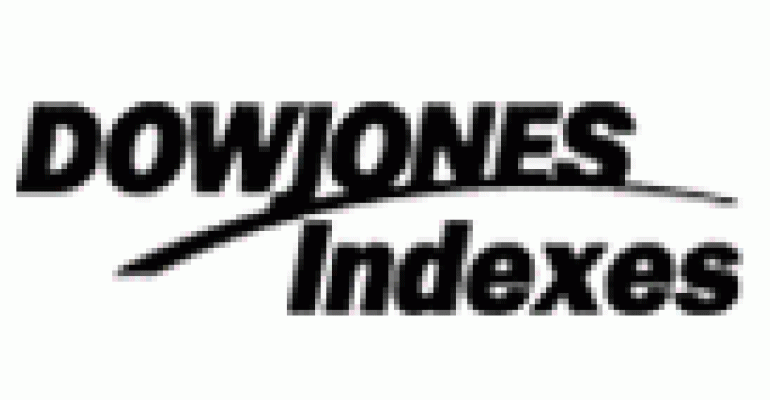Just looking at the volume numbers for the CBOE's broad-based index options tells the story: through June, total index volume was up 42% compared to the first half of 2002 at the CBOE, making indexes the exchange's fastest growing product.
 Now there is a way for traders and investors to make even more efficient hedges on index options: using futures on narrow-based security indexes, called Dow Jones MicroSector IndexesSM (MicroSector Indexes), to do sector rotations.
Now there is a way for traders and investors to make even more efficient hedges on index options: using futures on narrow-based security indexes, called Dow Jones MicroSector IndexesSM (MicroSector Indexes), to do sector rotations.
 In June, OneChicago began listing futures on 15 MicroSector Indexes, narrow-based security indexes that include five of the largest and most actively traded stocks in an industry sector.
In June, OneChicago began listing futures on 15 MicroSector Indexes, narrow-based security indexes that include five of the largest and most actively traded stocks in an industry sector.
MicroSector Index futures are only electronically traded on CBOEdirect, which can match trades in sub half-seconds from a handheld or a computer screen. They can be traded out of a securities or futures account and require a 20% margin that can be lowered if the investor also holds certain offsetting positions, e.g., cash equities, stock options or other security futures held in the same securities account. Leverage increases potential risk, however, and may not be suitable for all investors. You should consult your broker or financial advisor before using security futures to engage in leveraged transactions such as those described here.
And, unlike trading stocks outright, there is no need to wait for an uptick in the market to short the future on a MicroSector Index, nor is it necessary to borrow stock in order to short the future on a MicroSector Index.
The five securities in any MicroSector Index are highly correlated to each other and were selected from industry groupings based on the Dow Jones Global Classification Standard (DJGCS). The MicroSector Index approximates equal-dollar weighting of each component security. At selection, the number of total shares of all five component securities has a combined notional value of $40,000, or about $8,000 worth of shares from each of the five companies in the index.
Because the five securities in each MicroSector are highly correlated, you can trade an index of five sector-related securities with one commission fee as opposed to the five commissions you would incur trading those same correlated stocks outright. This also means that MicroSector Index futures enable investors to efficiently execute sector rotation trades and spreads.
The 15 MicroSector Index futures launched in June are Aerospace (XARO9C), Technology Hardware & Equipment (XTHQ9C), Banks (XBNK9C), Electric Utilities (XELC9C), Major Oil Companies (XOIL9C), Diversified Industrial (XIDD9C), Investment Services (XSCR9C), Biotechnology (XBTC9C), Communications Technology (XCMT9C), Diversified Financial (XFIS9C), Pharmaceuticals (XDRG9C), Precious Metals (XPCS9C), Retail (XRTS9C), Semiconductors (XSEM9C) and Software (XSOF9C).
Facilitating their ease of use with index options, futures on MicroSector Indexes also are cash settled with the last day of trading the third Thursday of each quarterly month. The final settlement price is calculated using the opening price of each component security during the regular trading session immediately following the last trading day. The CBOE intends to list options on MicroSector Indexes soon.
Here is how futures on the MicroSector Indexes work: Let's say an investor is bullish on the market as a whole but has some serious reservations about a certain sector, such as the banking industry, for example. The investor has calls on several broad-based indexes, such as the S&P 500 or one of the Exchange Traded Funds like the DIAMONDS, but he would also like to efficiently express his bearish sentiment regarding the banking sector while keeping his bullish positions on the broader indexes.
That can be done with one trade. While leaving his long broad-based index positions intact, the investor can go short the Banks MicroSector Index (XBNK9C), which currently includes Bank of America Corp. (BAC), HSBC Holdings PLC SDS (HRC), J.P. Morgan Chase & Co. (JPM), Washington Mutual (WM) and Wells Fargo & Co. (WFC). Now the investor is long the market as a whole but has hedged the banking sector holdings.
This same idea can be taken a step further for sector rotation strategies. Active sector rotation is a popular strategy among professional investors, but it is operationally intensive and expensive when implemented with stocks. As a result, many traders are reluctant to get in and out of their sector positions because it is expensive to be nimble when they need to be.
That is not the case with MicroSector Index futures. Because MicroSector futures are focused on key industry sectors with expected high correlation to overall sector performance, and due to the fact that they can be held in securities or futures accounts, have low transaction costs and are capital efficient, it is not as difficult, or costly, to move quickly. As a result, traders can buy and sell entire sectors using MicroSector Index futures for a fraction of the cost of buying and selling the same securities in the stock market.
For more information on MicroSector futures and their stock components, please visit the OneChicago Web site at www.OneChicago.com or email [email protected] with questions.
Dow Jones, "The Dow", "Dow Jones Industrial Average", "Dow Jones Industrials", "DJIA," "Dow Jones MicroSector Indexes" and "DIAMONDS" are service marks of Dow Jones & Company, Inc. and have been licensed for use for certain purposes by OneChicago, LLC. OneChicago's DIAMONDS futures and the OneChicago Dow Jones MicroSector Index Futures are not sponsored, endorsed, sold or promoted by Dow Jones, and Dow Jones makes no representation regarding the advisability of investing in such products.






